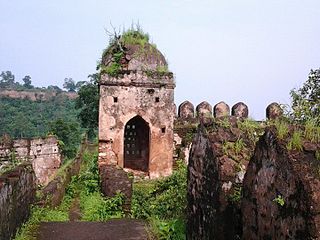
Korea State, currently spelt as Koriya, was a princely state of the British Empire of India. After Indian independence in 1947, the ruler of Korea acceded to the Union of India on 1 January 1948, and Koriya was made part of Surguja District of Central Provinces and Berar province. In January 1950, "Central Provinces and Berar" province was renamed Madhya Pradesh state. After November 2000, Korea and the former princely state of Changbhakar became Koriya district of Chhattisgarh state.
Bhaiyathan is a panchayat village in Surajpur District in the Indian state of Chhattisgarh. Bhaiyathan is part of a community development block under the jurisdiction of Surajpur district and is 23 km away from Supurown. It is situated on the bank of the Rihand River. Tamor Pingla Wildlife Sanctuary is a major attraction nearby. A famous Devi temple on a hill, Kudargarh, is just 23 km from Bhaiyathan.

Rewa State, also known as Rewah, was a princely state of India, surrounding its eponymous capital, the town of Rewa.

Dhenkanal State was one of the princely states of India during the period of the British Raj. The state is now referred to as Dhenkanal district, Odisha, with Dhenkanal town as its district headquarters.
Dharamjaygarh is a town and a nagar panchayat in Raigarh District in the state of Chhattisgarh, India. Major languages spoken are Hindi and Chhattisgarhi, with a little Odia, Bengali and English. Laljeet Singh Rathia is a current MLA of the Dharamjaigarh constituency.

Changbhakar State, also known as Chang Bhakar, was one of the princely states of British Empire in India in the Chhattisgarh States Agency. It included 117 villages and had an area of 2,330 square kilometres (899 sq mi) with a 1941 population of 21,266 people. Bharatpur was the capital of the princely state.
Maharaja Sir Tej Singh Prabhakar, KCSI, was a ruler of Naruka dynasty of the Indian princely state of Alwar, Rajasthan from July 22, 1937 to 15 Aug 1947. Also, he was the last ruling Maharaja of Alwar.

Colonel HH Maharajadhiraj Shri Maharaja Mahim Mahendra Maharao Raja Sir Umaid Singh II was the 18th Hada Chauhan ruler of the Princely State of Kotah from the year 1889 to 1940.

The Palamu fort are two ruined forts located 3 k.m from Betla National Park, Latehar district on the bank of Auranga River, in the Indian state of Jharkhand. The old fort in the plains, which existed even before the Chero dynasty, was built by the King of Raksel dynasty. The original fort in the plains and the other on an adjoining hill are attributed to the kings of the Chero dynasty. The fort in the plains had defences on three sides and three main gates. The New fort was constructed by Raja Medini Ray. East India company used this fort to prison Narayan Peshwa of Tiroha and Raja Radhkrishna alis Subedar Aftab Singh mutineers of 1857.

The following list includes a brief about the titles of nobility or orders of chivalry used by the Marathas of India and by the Marathis/Konkanis in general.

Raigarh was a princely state in India at the time of the British Raj. The state was ruled by a Gond dynasty of Gond clan.

Gaurihar State was a princely state in India, ruling a territory that is now in Madhya Pradesh. Gaurihar is a tehsil of Chhatarpur district.

Kharsawan State, also spelt Kharsua or kharaswan, (Odia:ଖରସୁଆଁ)was a princely state in India during the era of the British Raj. The state had a privy purse of 33,000 Rs.It was one of the Odia Princely states of India during the period of the British Raj and the major language spoken in the area is Odia.

Surguja State was one of the main princely states of Central India during the period of the British Raj, even though it was not entitled to any gun salute. Formerly it was placed under the Central India Agency, but in 1905 it was transferred to the Eastern States Agency.

Jashpur State was one of the princely states of India during the period of the British Raj. The town of Jashpur was the former state's capital. The rulers were Rajputs of Chauhan Clan.
Raja Bhup Deo Singh Bahadur (1867–1917) was the Raja of Raigarh and Chief of Bargarh ruled by Gond dynasty. He was the ruler of the Princely state of Raigarh from 1894 till his death in 1917. He was son of Raja Deo Nath Singh. Bhup Deo Singh was installed on throne on 1894 with title of Raja. British Gazetteer mentions he was educated and exercised personal control over affairs of his state In 1911 status of the state was raised and the title Raja Bahadur was given to the rulers by British. He died in 1917 and his son Raja Natwar Singh succeeded him as next ruler.













